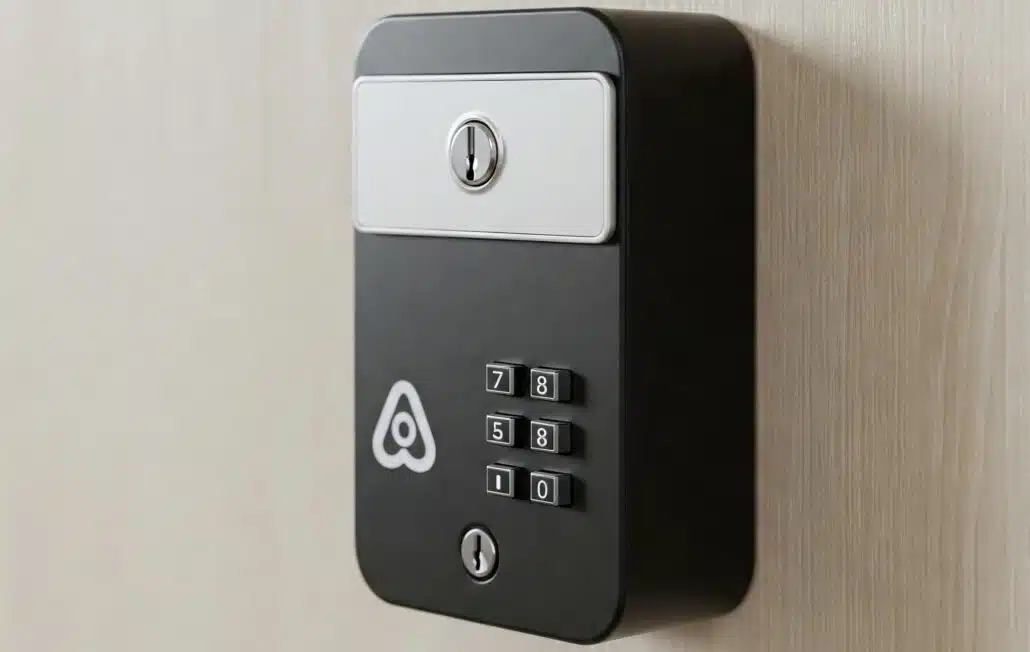The importance of self check-in for Airbnb hosts
Benefits of self check-in for hosts
Self check-in has revolutionized the way Airbnb hosts manage their properties, offering a variety of benefits tailored to both hosts’ operational needs and guests’ preferences:
- Flexibility for hosts: Self check-in liberates hosts from the constraints of strict schedules. Whether managing multiple listings or balancing a busy personal life, it eliminates the need for in-person key exchanges, providing hosts with the flexibility to manage their time more effectively.
- Enhanced guest experience: Guests highly value the ability to check in at their convenience, especially if they are arriving late at night or outside typical hours. This flexibility not only enhances their experience but also increases guest satisfaction and positive reviews.
- Cost efficiency: By removing the need for in-person meetups, hosts can reduce expenses related to hiring property managers or additional staff for check-ins, making self check-in a cost-effective solution.
- Operational efficiency: Automating the check-in process minimizes the time and effort required to coordinate with guests, which is especially beneficial for hosts managing multiple properties.
- Broader appeal: Offering self check-in can make your property more attractive to a wider audience, including last-minute bookers, travelers with tight schedules, and international guests arriving at various times.
The rising demand for contactless check-ins
The shift towards contactless check-ins has accelerated, driven by global health concerns and the growing preference for privacy and convenience:
- Health and safety: In a post-pandemic world, contactless check-ins offer a safer alternative by minimizing physical interactions. This approach aligns with current health guidelines, providing peace of mind for both hosts and guests.
- Guest privacy: Many travelers prefer the privacy that contactless check-ins provide, allowing them to access the property without the need for direct interaction with the host. This is particularly appealing after long journeys or for those seeking a more private experience.
- Staying competitive: The hospitality industry is increasingly embracing automation and digital solutions. By offering contactless check-ins, hosts can stay ahead of market trends, ensuring their properties remain competitive and appealing to modern travelers.
- Technology integration: Contactless check-ins often leverage smart lock technology, enhancing security and allowing hosts to manage access remotely. This technological integration streamlines operations and provides a seamless guest experience.
- Sustainability and convenience: By reducing the need for physical keys and printed instructions, contactless check-ins contribute to more sustainable hosting practices. Additionally, guests appreciate the convenience of accessing information and entry codes digitally, further enhancing their experience.
By embracing both self-check-in and contactless check-in options, Airbnb hosts can elevate their service offerings, increase guest satisfaction, and maintain a competitive edge in an evolving market.

Comprehensive overview of Airbnb lockboxes
Airbnb lockboxes are a crucial tool for modern hosts, offering a secure and convenient method for guests to access their accommodations without requiring in-person key exchanges. Understanding the different types of lockboxes available allows hosts to choose the best option for their property and guest needs.
What is an Airbnb lockbox?
An Airbnb lockbox is a secure container, typically installed near the entrance of a property, where keys or access cards are stored for guests. This device allows guests to check in at their convenience using a code or combination provided by the host. The key benefits of lockboxes include:
- Security: Lockboxes are designed to protect keys from unauthorized access, reducing the risk of theft or loss.
- Convenience: They enable guests to arrive and check in at any time, making the process flexible and hassle-free.
- Contactless access: In today’s health-conscious environment, lockboxes allow guests to enter the property without physical interaction with the host, enhancing safety and privacy.
Exploring different types of lockboxes
There are various types of lockboxes available, each offering unique features and benefits. Understanding these options helps you select the most suitable lockbox for your property.
Smart locks
Smart locks represent the most advanced option, providing keyless entry through digital codes, smartphone apps, or biometric data. These locks often integrate with home automation systems, offering features such as:
- Remote access: Hosts can unlock doors for guests remotely or provide access codes via a mobile app.
- Customizable codes: Generate unique codes for each guest that can be set to expire after their stay, enhancing security.
- Integration with home automation: Compatible with systems like Amazon Alexa, Google Assistant, or Apple HomeKit, allowing for voice-activated control.
- Real-time monitoring: Receive notifications when guests enter or exit the property, providing additional peace of mind.
Push-button locks
Push button locks are a popular and user-friendly option, featuring a numbered keypad where guests enter a code to unlock the door. Key features include:
- Easy operation: Guests enter a numeric code to gain entry, making the process straightforward and accessible.
- Code resetting: Hosts can easily reset the code between stays to ensure security.
- Durability: These locks are generally robust and designed to withstand various weather conditions.
Dial and wheel lockboxes
Dial and wheel lockboxes are traditional, mechanical lockboxes that require guests to input a combination using rotating dials or wheels. They offer a reliable, low-tech solution with the following characteristics:
- Mechanical operation: No batteries or electronics required, reducing the risk of technical failures.
- Combination security: Guests turn the dials to match the correct combination, which can be reset by the host after each stay.
- Cost-effective: Typically less expensive than smart locks, making them an attractive option for budget-conscious hosts.
Backup lockboxes
Backup lockboxes serve as an additional security measure, ensuring that a physical key is available in case of technical issues with primary smart locks or when the primary lockbox is inaccessible. Features include:
- Redundancy: Provides a reliable fallback option if the main lockbox or smart lock fails.
- Simple design: Usually a basic lockbox with a combination or key-based mechanism, ensuring ease of use.
- Peace of mind: Hosts can relax knowing there’s always a way for guests to access the property, even in unforeseen circumstances.
By understanding the different types of Airbnb lockboxes, hosts can choose the right solution that balances security, convenience, and cost, ultimately enhancing the guest experience and making property management more efficient.
Maximizing the benefits of lockboxes for Airbnb hosts
Lockboxes have become indispensable for Airbnb hosts, offering significant advantages that cater to both the operational needs of hosts and the comfort of guests. Implementing a lockbox system can enhance your property’s security, streamline check-ins, and elevate the overall guest experience.
Convenience, safety, and cost efficiency for hosts
Lockboxes offer numerous benefits for hosts, simplifying property management and ensuring guest satisfaction:
Flexibility, privacy, and peace of mind for guests
- Convenience:
- Automated check-ins: Lockboxes allow guests to check in at any time without requiring the host’s physical presence. This automation is particularly beneficial for hosts managing multiple properties or those with busy schedules.
- Time management: With a lockbox, hosts save time by avoiding in-person key exchanges, freeing up valuable time for other property management tasks.
- Safety:
- Contactless check-ins: Lockboxes facilitate contactless check-ins, reducing the need for face-to-face interactions, which is crucial for maintaining health and safety standards.
- Secure key storage: Unlike hiding keys under doormats or other insecure locations, lockboxes provide a safe place to store keys, significantly reducing the risk of theft.
- Cost efficiency:
- Reduced staffing needs: With a lockbox system, there’s no need to hire additional staff for check-ins, saving on operational costs.
- Lower management costs: Hosts can manage their properties more efficiently with less reliance on third-party property managers, translating to significant cost savings.
Lockboxes greatly enhance the guest experience, offering a range of benefits that cater to the preferences of modern travelers:
- Flexibility:
- Anytime check-in: Guests can arrive and check in at their convenience, whether it’s late at night or early in the morning, without needing to coordinate with the host.
- No rush: Travelers can take their time arriving, knowing they don’t need to align their schedule with someone else’s.
- Privacy:
- Independent access: Guests appreciate the privacy of being able to enter the property on their own, without the need for interaction with the host, especially after a long journey.
- Reduced pressure: Many guests prefer to settle in without the pressure of a meet-and-greet, making their stay more comfortable.
- Peace of mind:
- Secure entry: Knowing that the keys are stored securely in a lockbox gives guests confidence that they won’t face issues accessing the property.
- Reduced stress: Guests don’t need to worry about miscommunication or delays, as the lockbox provides reliable and easy access to their accommodation.
Enhancing property security with lockboxes
One of the most significant advantages of using lockboxes is the enhanced security they provide for your property:
- Tamper-resistant design:
- Lockboxes are designed to be durable and resistant to tampering, protecting keys from unauthorized access.
- Secure code management:
- Customizable codes: Hosts can set unique access codes for each guest, which can be changed easily between stays, minimizing the risk of unauthorized entry.
- Monitoring access: Some lockboxes, especially smart lockboxes, allow hosts to monitor when the lockbox is accessed, providing an additional layer of security.
- Reduced risk of key loss:
- No more hidden keys: By storing keys in a lockbox, hosts eliminate the need to hide keys in insecure places like under a mat or a rock, reducing the likelihood of them being lost or stolen.
- Backup options: In case of technical issues with smart locks, a backup lockbox ensures that a physical key is always available, providing both hosts and guests with peace of mind.
Implementing a lockbox system not only streamlines the check-in process but also significantly enhances the security of your property, offering both hosts and guests a safer, more convenient, and enjoyable experience.
Selecting and maintaining the perfect lockbox for your property
Choosing and maintaining the right lockbox is essential for ensuring smooth check-ins and maintaining the security of your property. With various options available, it’s crucial to consider key factors to make an informed decision.
Key considerations: budget, location, and security needs
When selecting a lockbox, it’s important to evaluate several factors to ensure you choose the solution that best suits your property:
- Budget:
- Initial investment: Determine how much you’re willing to spend on a lockbox. Prices range from affordable mechanical options to more expensive smart lockboxes with advanced features.
- Long-term costs: Consider ongoing costs, such as battery replacements for smart locks or potential maintenance fees.
- Location:
- Property type: The location and type of your property (urban vs. rural, apartment vs. standalone house) can influence the type of lockbox that’s most appropriate.
- Installation site: Choose a lockbox that can be securely installed in a convenient yet discreet location, such as near the front door or a hidden spot that’s easily accessible to guests.
- Weather considerations: For properties in areas with harsh weather conditions, consider a weather-resistant lockbox to ensure durability.
- Security needs:
- Guest turnover: If you frequently host new guests, a lockbox with customizable codes or smart features may be necessary to enhance security.
- Crime rate: In higher-risk areas, opt for a lockbox with advanced security features, such as tamper-proof mechanisms and remote access monitoring.
Comparing costs: budget-friendly to high-end options
Understanding the cost differences between various lockboxes can help you make an informed decision that aligns with your financial and security needs:
- Budget-friendly options:
- Mechanical lockboxes: Typically priced between $20-$40, these lockboxes are simple, durable, and easy to use. They often feature a combination dial or push-button system and are ideal for hosts seeking a low-cost solution.
- Basic models: These may include dial and wheel lockboxes, offering reliable security without the need for batteries or complex installations.
- Mid-range options:
- Push button lockboxes: Priced around $40-$100, these lockboxes offer a balance between affordability and security. They usually have resettable codes, providing added security for frequent guest turnover.
- Weather-resistant models: For properties exposed to extreme weather, consider mid-range lockboxes with enhanced durability features.
- High-end options:
- Smart lockboxes: Ranging from $100-$300, these advanced models offer features like remote access, customizable digital codes, and integration with home automation systems. They provide maximum security and convenience, making them ideal for high-traffic or luxury properties.
- Advanced security features: High-end lockboxes often include tamper alerts, remote monitoring, and even biometric access, ensuring top-level security for your property.
Smart vs. traditional lockboxes: making the right choice
Choosing between smart and traditional lockboxes depends on your property’s needs and your preference for technology integration:
- Smart lockboxes:
- Pros:
- Remote access: Control and monitor the lockbox from anywhere using a smartphone app, making it convenient for hosts managing multiple properties.
- Customizable codes: Generate unique codes for each guest, enhancing security and minimizing the risk of unauthorized access.
- Integration with smart home systems: Sync with devices like Amazon Alexa or Google Assistant for seamless home automation.
- Real-time notifications: Receive alerts when the lockbox is accessed, providing added peace of mind.
- Cons:
- Higher cost: Smart lockboxes are generally more expensive, both in terms of initial investment and potential maintenance.
- Dependence on technology: These lockboxes rely on batteries and internet connectivity, which could be problematic in case of power outages or technical issues.
- Pros:
- Traditional lockboxes:
- Pros:
- Affordability: Typically less expensive than smart models, making them a cost-effective choice for budget-conscious hosts.
- Simplicity: Easy to use with no need for batteries or internet, reducing the risk of malfunction.
- Reliability: Mechanical models are robust and less likely to fail due to technical issues.
- Cons:
- Limited features: Lacks the advanced features of smart lockboxes, such as remote access or digital code customization.
- Manual code management: Requires manual code changes between guests, which may be less convenient for hosts with high guest turnover.
- Pros:
By weighing the pros and cons of smart versus traditional lockboxes and considering your specific needs, you can select the lockbox that best aligns with your property management style, ensuring a secure and convenient experience for both you and your guests.
Best practices for lockbox installation and maintenance
Proper installation and regular maintenance of your lockbox are essential for ensuring security and ease of access for your guests. By following best practices for installation, weatherproofing, and maintenance, you can maximize the lifespan of your lockbox and provide a seamless check-in experience.
Strategic installation: balancing accessibility and security
Choosing the right location for your lockbox is crucial for balancing accessibility with security. Here are some key considerations:
- Near the main entrance:
- Guest convenience: Install the lockbox close to the main entrance, such as near the front door or on a porch, so guests can easily access the keys without searching.
- Visibility: Ensure the location is visible enough for guests to find but not so conspicuous that it attracts unwanted attention. A spot that is easily described in check-in instructions but not directly in plain sight is ideal.
- Discreet locations:
- Side of the house: Installing the lockbox on the side of the house, out of direct view from the street, can help keep it hidden from potential thieves while still being accessible to guests.
- Garden or backyard: For properties with gardens or backyards, consider placing the lockbox in a less obvious spot, such as behind a planter or near a gate, to enhance security.
- Apartment complexes:
- Shared spaces: In apartment complexes, place the lockbox in a discreet location near the entrance but away from high-traffic areas to avoid tampering. You might also consider placing it behind the first gate or inside a secondary secure area.
- Secure mounting: Ensure the lockbox is securely mounted to a wall or a sturdy surface to prevent it from being easily removed or tampered with.
Weatherproofing and securing your lockbox
Protecting your lockbox from the elements and potential security threats is essential for maintaining its functionality and ensuring guest access:
- Weatherproofing:
- Protective covers: Use a weatherproof cover or case to shield your lockbox from rain, snow, and extreme temperatures, which can cause rust or damage to the locking mechanism.
- Strategic placement: Install the lockbox in a sheltered area, such as under an eave or inside a covered porch, to minimize exposure to harsh weather conditions.
- Material choice: Opt for lockboxes made of durable, weather-resistant materials like stainless steel or heavy-duty plastic to withstand the elements.
- Securing the lockbox:
- Sturdy mounting: Ensure the lockbox is securely fastened to a solid structure, such as a wall or fence, using strong screws or bolts. This prevents the box from being easily pried off or tampered with.
- Tamper-resistant features: Consider lockboxes with built-in tamper-resistant features, such as hidden screws or reinforced construction, to deter potential thieves.
- Discreet placement: Keep the lockbox out of plain sight from the street or public areas to reduce the risk of it being targeted by thieves.
Essential maintenance: changing codes and handling technical issues
Regular maintenance of your lockbox is vital for ensuring it remains secure and functional over time. Here are some key maintenance practices:
- Regular code changes:
- Between guests: Change the access code after each guest checks out to ensure that only current guests have access to the property. This is especially important for properties with high turnover.
- Complex codes: Use complex, unpredictable codes to enhance security and reduce the likelihood of unauthorized access.
- Code management: Keep a secure record of all codes, especially for smart lockboxes, to manage access effectively and avoid confusion.
- Handling technical issues:
- Battery checks: For smart lockboxes, regularly check and replace batteries to prevent lockouts due to power failure. Most smart lockboxes will notify you when the battery is low, but it’s a good idea to have a regular schedule for checking.
- Software updates: Keep the software for smart lockboxes up to date to ensure smooth operation and security enhancements. Regular updates can fix bugs and improve performance.
- Backup solutions: Have a backup plan in place, such as a secondary lockbox or an emergency contact number, in case the primary lockbox fails. This ensures that guests can still access the property if something goes wrong.
- Routine inspections:
- Visual checks: Regularly inspect the lockbox for signs of wear, damage, or tampering. Address any issues immediately to maintain security.
- Cleaning: Keep the lockbox clean and free from debris, especially around the locking mechanism, to prevent jamming or other operational issues.
By carefully considering installation locations, weatherproofing, and maintaining your lockbox, you can ensure that it remains a reliable and secure solution for your Airbnb property, providing both you and your guests with peace of mind.
Real-world applications: lockbox use cases and best practices
Understanding when and how to effectively use a lockbox can significantly enhance both the guest experience and the efficiency of property management. Here, we explore common scenarios where lockboxes are invaluable and provide insights into how Superhosts leverage them to elevate their hosting practices.
Common scenarios for lockbox use
Lockboxes are a versatile tool that can be beneficial in a variety of hosting situations. Here are some common scenarios where using a lockbox is particularly advantageous:
- Late-night arrivals:
- Guest flexibility: If guests are arriving late at night or during non-traditional hours, a lockbox allows them to check in at their convenience without needing the host to be present.
- Unforeseen delays: Flight delays, traffic, or other unforeseen circumstances can push back a guest’s arrival time. A lockbox ensures they can still access the property without stress.
- Remote hosting:
- Multiple properties: For hosts managing multiple properties or those who live far from their rental, a lockbox is an essential tool for ensuring guests can access the property without requiring the host to be on-site.
- Traveling hosts: If you’re a host who travels frequently, a lockbox provides a reliable way for guests to check in while you’re away.
- High guest turnover:
- Frequent bookings: In properties with high turnover, where guests check in and out frequently, a lockbox streamlines the process, making it easy to manage multiple check-ins and check-outs.
- Self check-in preference: Many guests, especially business travelers or those on tight schedules, prefer self-check-in options. A lockbox caters to this preference, improving guest satisfaction.
- Contactless check-ins:
- Health and safety concerns: In situations where minimizing contact is a priority (e.g., during a pandemic), a lockbox facilitates a completely contactless check-in process, ensuring the safety of both guests and hosts.
- Guest privacy: Some guests prefer to avoid interaction with the host, especially after a long journey. A lockbox allows them to check in privately and at their own pace.
- Emergency situations:
- Lockouts: In case of a guest lockout, having a backup key in a lockbox can save time and prevent frustration.
- Backup access: If the primary entry method (e.g., a smart lock) fails due to technical issues, a lockbox with a physical key ensures that guests can still access the property.
Superhost strategies: leveraging lockboxes to enhance guest experience
Superhosts, known for their exceptional hospitality and high guest ratings, often use lockboxes to enhance their guest experience. Here’s how they do it:
- Seamless check-in process:
- Detailed instructions: Superhosts provide clear, step-by-step instructions on how to use the lockbox, including its location and how to enter the access code. This ensures a smooth and stress-free check-in process.
- Personalized welcome: Even with a lockbox, Superhosts often go the extra mile by leaving a personalized welcome note or small gift inside the property, making guests feel valued right from the start.
- Enhanced communication:
- Proactive communication: Superhosts use messaging platforms to proactively communicate with guests, confirming their check-in process and ensuring they have no trouble accessing the lockbox. This helps build trust and reduces any potential anxiety guests might have.
- 24/7 availability: Superhosts make themselves available to address any issues that may arise with the lockbox, such as code errors or difficulty in locating it, providing peace of mind to their guests.
- Security and peace of mind:
- Regular code changes: To ensure security, Superhosts change the lockbox code after every guest. This practice not only enhances security but also reassures guests that their safety is a priority.
- Emergency backup: Superhosts often have a secondary lockbox or an alternative entry method as a backup in case the primary lockbox fails. This ensures that guests are never locked out or left waiting.
- Customized experience:
- Flexible check-in times: By using a lockbox, Superhosts offer guests the flexibility to check in whenever they want, catering to different travel schedules and making the experience more convenient.
- Personal touch: Despite the automated check-in process, Superhosts find ways to add a personal touch, such as providing local recommendations or setting up the property to meet specific guest preferences (e.g., adjusting the temperature or lighting).
- Efficiency in property management:
- Streamlined operations: Superhosts use lockboxes to streamline their operations, particularly when managing multiple properties. This efficiency not only benefits the host but also ensures that guests experience a seamless stay from start to finish.
- Guest autonomy: By offering self-check-in through a lockbox, Superhosts empower guests to start their stay independently, which is especially appreciated by seasoned travelers who prefer minimal interaction.
By strategically using lockboxes, Superhosts can provide an enhanced, hassle-free experience that meets the needs of today’s travelers while maintaining the high standards that earn them top ratings. Whether it’s through improved security, convenience, or guest autonomy, lockboxes play a vital role in helping Superhosts deliver exceptional hospitality.
Streamlining success with smart solutions
Investing in quality self check-in and keyless entry solutions is essential for securing your vacation rental property while enhancing the guest experience. By implementing the right technology, you can provide a secure, efficient, and welcoming environment that sets the stage for successful hosting.
Ready to take your property management to the next level? Guesty’s Marketplace offers an extensive selection of vetted lockbox, smart lock, and keyless entry partners that seamlessly integrate with your existing systems. From advanced keypad solutions to smartphone-enabled access systems, Guesty connects you with industry-leading technology providers that can transform your check-in process while maintaining the highest security standards.





